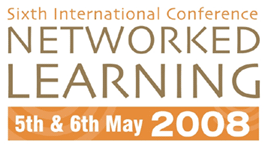

The implementation of a Web-based Learning Environment concerning teachers' collaboration in the area of Fluids
Paraskevas. A., Psillos. D.
Department of Primary Education, University of Thessaloniki, Greece
aparaske@eled.auth.gr , psillos@eled.auth.gr
Abstract
In our work we developed and implemented a specially developed web-based
distance learning course, addressed to in service primary teachers in
Greece in the area of fluids. The course aims at enhancing participants'
understanding of fluids and as well as their collaboration towards producing
teaching learning materials for their pupils. Fluids is taught in primary
schools, in several countries including Greece, in which pupils and teachers
have alternative views and difficulties, in understanding basic ideas
concerning pressure and buoyancy. We implemented a specific strategy,
in order to promote asynchronous collaboration among participants and
evaluated results by using Murphy`s quantitative content analysis model.
During recent years, in the area of higher education, a great number of
applications have used Web-based learning environments, in order to support
distance learning courses and computer supported collaborative approaches,
in learning and problem solving, in several areas. Computer-mediated communication
can facilitate collaborative learning strategies and approaches, thus
providing opportunities for virtual communities of learners to collaborate
in ways that lead to shared understanding. Evaluating on-line collaborative
learning interactions is a complex task due to the variety of elements
and factors that take place and intervene, in the way a group of participants
comes together to collaborate, in order to achieve a learning goal. In
this context, we developed a web based teaching strategy aiming at enhancing
participants' understanding of fluids and as well as their collaboration
towards producing teaching learning materials for their pupils. In the
present study, we report on the strategy and the collaborative activities
of participating teachers. The sample of our study consisted of twenty
four, (24), experienced primary teachers, who attended a two years in
service program at the Department of Primary Education, University of
Thessaloniki. In developing the course, first software for the Web based
learning environment implementation was chosen and the open source software
B.S.C.W. (Basic Support for Collaborative Work), has been chosen, because
it is free for academic use,(http://bscw.gmd.de/ ). Second specially developed
materials in the area of fluids were digitized and uploaded to the environment.
Third based on data from two pilot studies, we designed a special mixed
strategy in order to enhance teacher’s collaboration. In order to
identify collaboration possibilities, among teachers, we carried out quantitative
content analysis of their written dialogues, using the widely applied
model of Murphy.
It is characteristic that one hundred fifty seven messages (157), found
in the phases "co-construct shared perspectives" and "building
shared goals", constitute the two thirds of the total messages. This
number seems to point out that participants, despite the high complexity
of the scientific topic, successfully managed to co-construct shared perspectives
and building shared goals, taking under consideration content knowledge.
It is possible that enhancement of their understandings of pressure and
buoyancy supplied before the collaborative phase of the strategy facilitated
participants to reach the higher levels in Murphy’s' model. As a
matter of fact achieving such levels in web based collaborative activities
may not be taken for granted, (Murphy, 2004). In other words we consider
that if content knowledge was insufficient, we might found postings only
from the first two phases of Murphy`s model, (social interaction &
articulating individual perspectives), perhaps as monologues.
The production of twelve shared artefacts from all participants, considered
as identification and completion of collaboration. That is also a key
element therefore all participants reached that phase, without any withdraws.
We consider that participants were helped to achieve such goal by being
specifically guided on how to collaborate instead of being left to proceed
without instruction in a learning situation for which they had little
prior experience.
| About NLC |
2008 Conference Papers
| Conference Committee| Keynote
Speakers
| Papers from previous NL conferences |Research Seminars| Current Conference
| Sponsors | Contact
|
